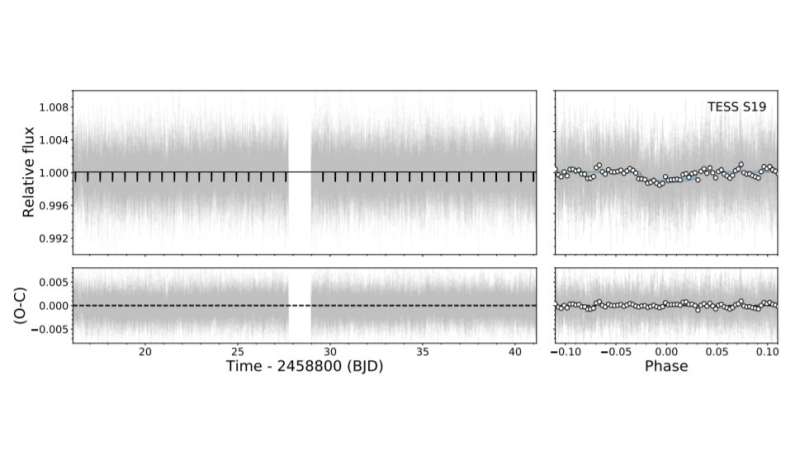
Using NASA's Transiting Exoplanet Survey Satellite (TESS), an international team of astronomers has detected a new super-Earth exoplanet. The newfound alien world, designated TOI-1685b, is about 70% larger than Earth and has an ultra-short orbital period of approximately 0.67 days. The finding is reported in a paper published March 1 on arXiv.org.
TESS is conducting a survey of about 200,000 of the brightest stars near the sun with the aim of finding transiting exoplanets. So far, it has identified over 2,500 candidate exoplanets (TESS Objects of Interest, or TOI), of which 113 have been confirmed so far.
Now, a team of astronomers led by Paz Bluhm of the Heidelberg University in Germany, reports the finding of another exoplanet using this spacecraft. Between November 28 and December 23, 2019, TESS observed a nearby M dwarf star known as TOI-1685, which resulted in the detection of a transit signal in the light curve of this object. The planetary nature of this signal was confirmed by follow-up precise radial velocity (RV) measurements using the CARMENES (Calar Alto high-Resolution search for M dwarfs with Exoearths with Near-infrared and optical Échelle Spectrographs) instrument.
"We present the discovery of the ultra-short-period planet TOI-1685b, which orbits its host star with a period of 0.669 d. To confirm the planetary nature of the TESS transiting candidate we obtained high resolution spectra using the CARMENES spectrograph," the astronomers wrote in the paper.
According to the study, TOI-1685b has a radius of approximately 1.7 Earth radii and is about 3.78 times more massive than Earth, which means that it has a bulk density at a level of 4.21 g/cm3. These parameters make TOI-1685b the least dense ultra-short-period planet around an M dwarf known to date.
The equilibrium temperature of TOI-1685b was estimated to be about 1,069 K. Therefore, it turns out to be one of the hottest transiting Earth-size exoplanets with accurate dynamical mass measurements.
The host TOI-1685 is an M dwarf of spectral type M3.0 V, at a distance of some 122.5 light years from the Earth. It is about half the size and mass of our sun, and has an effective temperature of 3,434 K. The star's metallicity was measured to be at a level of -0.13, while its age is estimated to be between 0.6 and 2 billion years.
Additionally, the astronomers found evidence of one more planet that could be orbiting the star TOI-1685. The planetary candidate, designated TOI-1685[c], is estimated to have an orbital period of about 9.02 days. Further observations of TOI-1685 are required in order to confirm whether or not the object belongs to this system.
"Based on the currently available RV data, it is not possible to confidently claim the detection of a second planet in the system. To reach a solid conclusion, more data will be needed," the researchers explained.
© 2021 Science X Network
Citation: Ultra-short-period super-Earth detected by TESS (2021, March 9) retrieved 9 March 2021 from https://ift.tt/3eA9HTZ
This document is subject to copyright. Apart from any fair dealing for the purpose of private study or research, no part may be reproduced without the written permission. The content is provided for information purposes only.
"Short" - Google News
March 09, 2021 at 09:00PM
https://ift.tt/3eA9HTZ
Ultra-short-period super-Earth detected by TESS - Phys.org
"Short" - Google News
https://ift.tt/2QJPxcA
Bagikan Berita Ini














0 Response to "Ultra-short-period super-Earth detected by TESS - Phys.org"
Post a Comment